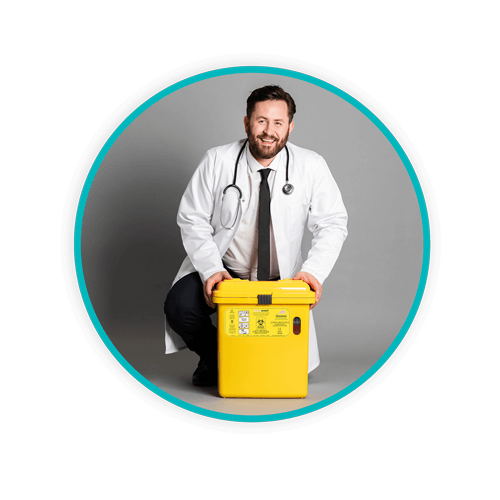Biomedical Waste Management Guidelines for Surrey, B.C.

Located between the border to the US and the Fraser River, Surrey is a suburb of Vancouver. With 500,000 residents and six major hospitals, not including outpatient clinics, dental offices, care centres, and veterinary services, biomedical waste accumulates. Proper biomedical waste management is vital for the safety of not only healthcare professionals, but their patients and the environment.
TOPICS WE WILL COVER:
2 / What do Canadian rules say about biomedical waste management?
3 / Handling and storage considerations
4 / Following the rules leads to compliance
5 / Storage and disposal of biomedical waste
What is biomedical waste?
The Canadian government has defined biomedical waste as “waste generated in human and animal healthcare facilities, medical or veterinary research and training facilities, clinical testing or research laboratories.”
All Canadian provinces have their own rules and regulations regarding biomedical waste management. Such management covers topics of segregation, handling, storage, and ultimate disposal of biomedical waste. However, all regulations – federal, provincial, and municipal – must be followed to avoid risk of non-compliance and potential fines and penalties.
In most cases, every province within Canadian borders has their own governmental definitions of biomedical waste. However, biomedical waste disposal processes of both the federal government and the provincial governments must also be followed.
The province of British Columbia defines biomedical waste as:
- Sharps waste
- Microbiological waste
- Anatomical waste (solid and liquid) from humans or animals
- Non-anatomical waste
- Chemical and pharmaceutical waste
Every province has their own definitions of biomedical waste. While they differ primarily in wording, they are typically similar.
What do Canadian rules say about biomedical waste management?
Any biomedical waste generator in British Columbia can find federal guidelines for all types of medical and healthcare medical waste and disposal processes. For example, the Canadian Environmental Protection Act (CEPA) provides specifics for healthcare waste disposal processes. A number of various waste streams (including biomedical waste) can be found in the act.
Waste generators and healthcare facilities should also be familiar with the Guidelines for the Management of Biomedical Waste in Canada. The document gives details for compliant packaging, segregating, and treatment options for biomedical waste regardless of provincial location. Disposal options are also given for many waste stream categories.
Finally, the document also offers guidance regarding off-site transportation of biomedical waste. Before any biomedical waste is disposed of, it must be handled and stored properly.
Ensure safe and compliant handling of waste materials in any medical, dental, or veterinary facility. This ensures development and implementation of compliant biomedical waste management procedures. Some considerations include:
- Movement of wastes
- Waste segregation
- Record-keeping
- Compliant containers and their use
- Single-use and reusable containers
- Sharps containers
- About Storage and storage areas
Pay special attention to storage and packaging of different types of biomedical waste that include human and animal anatomical waste. Treatment and disposal options are also defined.
Handling and storage considerations
Any healthcare facility employee who handles or transports biomedical waste must know how to properly bag, pack, or store it before on-site or off-site disposal. The same goes for any waste that might potentially be hazardous or biohazardous in nature.
Factors to consider when segregating medical waste include the type of waste and use of compliant and appropriate colour-coding and labelling procedures. Before medical waste of any kind is transported off-site, you must also be familiar with transportation regulations and local regulatory requirements.
Guidelines for storage of biomedical waste after it’s been collected from the examination or patient’s room, a surgical suite, or otherwise must be followed for the safety of all personnel before it’s removed from its point of generation. Prior to transportation, biomedical waste must be stored in an area that is separated from any supplies of food or food preparation areas. Storage areas must also be secured and enclosed to prevent unauthorized access.
Storage areas must also be appropriately signed, and all bags, packages, boxes, and bins must be labelled or identified as a biomedical waste with biohazard symbols. Federal guidelines provide instructions for storage temperatures. As an example, biomedical waste is to be refrigerated at 4°C or lower if stored for more than four days. However, you must also follow provincial or territorial authorities for specific time frames, which might differ between provinces and municipalities.
British Columbia guidelines (which include Surrey) recommend that before disposal in a sanitary landfill, waste sharps are to be rendered unusable. This can be achieved through solidification, incineration, disinfection, or grinding.
More guidelines for storage and disposal of biomedical waste can be found under Section 16.2 (Storage and disposal of biomedical waste) of the Canadian Biosafety Handbook document.
Following the rules leads to compliance
All biomedical waste producers in British Columbia can also access their website (www2.gov.bc.ca) to review provincial and national links for all healthcare waste generators. These links include the British Columbia Environment Industry Association and the British Columbia Ministry of Transportation and Infrastructure.
Federal resources include:
- Canadian Council of Ministers of the Environment (CCME)
- Canadian Environmental Protection Act
- Environment Canada
- Transportation of Dangerous Goods Act and Regulations
Chapters 16 through 20 of the Canadian Biosafety Handbook, contain procedures and policies specifically targeted for biomedical waste management. They caution that “additional waste management considerations or requirements specified by the provincial, territorial, or local (municipal) authorities may also apply and should be consulted and complied with when establishing and implementing a waste management program.”
Special attention should be given to Section 16.1.1 (Human Anatomical Waste) – which means “all human tissues, organs, and body parts, excluding hair, nails, and teeth.” Be aware that “even after disinfection or decontamination, human anatomical waste is still considered biomedical waste and may require special means of disposal depending on applicable provincial, territorial, and local legislation.”
Sharps waste consists of needles, syringes, blades, or glass that may be contaminated with infectious material and can cause puncture wounds or cuts. It should be noted that “… sharps waste is no longer considered biomedical waste once it has been effectively decontaminated.”
Storage and disposal of biomedical waste
The guidelines for storage considerations are provided in Section 16.2 of the Canadian Biosafety Hanbook. Rules are specific for storage and disposal of biomedical waste. Biomedical waste must be decontaminated before disposal to ensure protection of the wildlife, the environment, and public health. Biomedical waste must be segregated and disposed of as near to its generation as possible.
Human anatomical waste (which includes blood, body fluids, or animal waste) is to be stored in leak-proof, puncture-proof, and tear-proof resistant waste bags or appropriate and compliant containers. Waste bags must be sealed and then placed in leak-proof containers and stored in a cold room, a freezer, or a refrigerator prior to decontamination. Sharps waste must be disposed of in puncture-resistant containers that maintain compliance with the National Standard of Canada.
In cases where biomedical waste is not immediately decontaminated or disposed of, it can be stored temporarily. However, it must be separated from other waste and stored an area that is secured and marked with a biohazard symbol. Keep in mind that some wastes must be stored in refrigerated areas to prevent putrefaction.
Risk management and assessment processes can greatly reduce the risk of improper, dangerous, or non-compliant disposal of biomedical waste in British Columbia.

Daniels Health Canada
For all your medical waste management needs, contact Daniels Health Canada for information, resources, and products that ensure you remain compliant with not just British Columbia regulations, but federal laws and regulations as well.
Let's Talk!
Your time is valuable, and we don’t want to play hard to get. You can either phone us directly on the details listed on our contact page, or feel free to fill out this short form and one of our team members will get back to you as quickly as possible.
